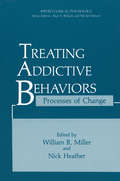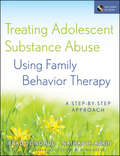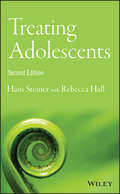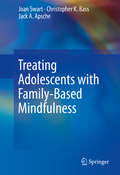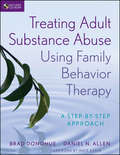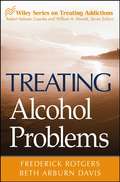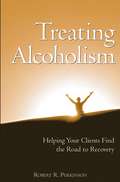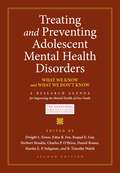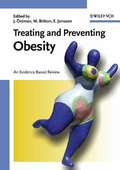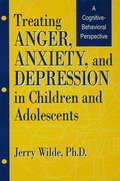- Table View
- List View
Traversing the Fantasy: The Dialectic of Desire/Fantasy and the Ethics of Narrative Cinema
by Sandra Meiri Odeya Kohen-RazTraversing the Fantasy: The Dialectic of Desire/Fantasy proposes a new and comprehensive model of spectatorship at the heart of which it draws an analogy between the ethics of Lacanian psychoanalysis and the ethics of narrative film. It demonstrates how spectators engage with narrative film, undergoing unconscious processes that generate a shift in the adherence to fantasies that impede assuming responsibility for one's fate and well being. The authors discuss the affinities that the ontology and aesthetics of narrative film share with subjective, unconscious processes, offering new insights into the popular appeal of narrative film, through three film corpora, analyzed at length: body-character-breach films; dreaming-character films; and gender-crossing films. With a range of case studies from the old (Rebecca, Vertigo, Some Like it Hot) to the new (Being John Malkovich, A Fantastic Woman), Sandra Meiri and Odeya Kohen Raz build on psychoanalytic ideas about the cinema and take them in a completely new direction that promises to be the basis for further developments in the field.
Travesti: Sex, Gender, and Culture among Brazilian Transgendered Prostitutes (Worlds of Desire: The Chicago Series on Sexuality, Gender, and Culture)
by Don KulickIn this dramatic and compelling narrative, anthropologist Don Kulick follows the lives of a group of transgendered prostitutes (called travestis in Portuguese) in the Brazilian city Salvador. Travestis are males who, often beginning at ages as young as ten, adopt female names, clothing styles, hairstyles, and linguistic pronouns. More dramatically, they ingest massive doses of female hormones and inject up to twenty liters of industrial silicone into their bodies to create breasts, wide hips, and large thighs and buttocks. Despite such irreversible physiological changes, virtually no travesti identifies herself as a woman. Moreover, travestis regard any male who does so as mentally disturbed. Kulick analyzes the various ways travestis modify their bodies, explores the motivations that lead them to choose this particular gendered identity, and examines the complex relationships that they maintain with one another, their boyfriends, and their families. Kulick also looks at how travestis earn their living through prostitution and discusses the reasons prostitution, for most travestis, is a positive and affirmative experience. Arguing that transgenderism never occurs in a "natural" or arbitrary form, Kulick shows how it is created in specific social contexts and assumes specific social forms. Furthermore, Kulick suggests that travestis—far from deviating from normative gendered expectations—may in fact distill and perfect the messages that give meaning to gender throughout Brazilian society and possibly throughout much of Latin America. Through Kulick's engaging voice and sharp analysis, this elegantly rendered account is not only a landmark study in its discipline but also a fascinating read for anyone interested in sexuality and gender.
Travesti: Sex, Gender, and Culture among Brazilian Transgendered Prostitutes (Worlds of Desire: The Chicago Series on Sexuality, Gender, and Culture)
by Don KulickIn this dramatic and compelling narrative, anthropologist Don Kulick follows the lives of a group of transgendered prostitutes (called travestis in Portuguese) in the Brazilian city Salvador. Travestis are males who, often beginning at ages as young as ten, adopt female names, clothing styles, hairstyles, and linguistic pronouns. More dramatically, they ingest massive doses of female hormones and inject up to twenty liters of industrial silicone into their bodies to create breasts, wide hips, and large thighs and buttocks. Despite such irreversible physiological changes, virtually no travesti identifies herself as a woman. Moreover, travestis regard any male who does so as mentally disturbed. Kulick analyzes the various ways travestis modify their bodies, explores the motivations that lead them to choose this particular gendered identity, and examines the complex relationships that they maintain with one another, their boyfriends, and their families. Kulick also looks at how travestis earn their living through prostitution and discusses the reasons prostitution, for most travestis, is a positive and affirmative experience. Arguing that transgenderism never occurs in a "natural" or arbitrary form, Kulick shows how it is created in specific social contexts and assumes specific social forms. Furthermore, Kulick suggests that travestis—far from deviating from normative gendered expectations—may in fact distill and perfect the messages that give meaning to gender throughout Brazilian society and possibly throughout much of Latin America. Through Kulick's engaging voice and sharp analysis, this elegantly rendered account is not only a landmark study in its discipline but also a fascinating read for anyone interested in sexuality and gender.
Travesti: Sex, Gender, and Culture among Brazilian Transgendered Prostitutes (Worlds of Desire: The Chicago Series on Sexuality, Gender, and Culture)
by Don KulickIn this dramatic and compelling narrative, anthropologist Don Kulick follows the lives of a group of transgendered prostitutes (called travestis in Portuguese) in the Brazilian city Salvador. Travestis are males who, often beginning at ages as young as ten, adopt female names, clothing styles, hairstyles, and linguistic pronouns. More dramatically, they ingest massive doses of female hormones and inject up to twenty liters of industrial silicone into their bodies to create breasts, wide hips, and large thighs and buttocks. Despite such irreversible physiological changes, virtually no travesti identifies herself as a woman. Moreover, travestis regard any male who does so as mentally disturbed. Kulick analyzes the various ways travestis modify their bodies, explores the motivations that lead them to choose this particular gendered identity, and examines the complex relationships that they maintain with one another, their boyfriends, and their families. Kulick also looks at how travestis earn their living through prostitution and discusses the reasons prostitution, for most travestis, is a positive and affirmative experience. Arguing that transgenderism never occurs in a "natural" or arbitrary form, Kulick shows how it is created in specific social contexts and assumes specific social forms. Furthermore, Kulick suggests that travestis—far from deviating from normative gendered expectations—may in fact distill and perfect the messages that give meaning to gender throughout Brazilian society and possibly throughout much of Latin America. Through Kulick's engaging voice and sharp analysis, this elegantly rendered account is not only a landmark study in its discipline but also a fascinating read for anyone interested in sexuality and gender.
Travesti: Sex, Gender, and Culture among Brazilian Transgendered Prostitutes (Worlds of Desire: The Chicago Series on Sexuality, Gender, and Culture)
by Don KulickIn this dramatic and compelling narrative, anthropologist Don Kulick follows the lives of a group of transgendered prostitutes (called travestis in Portuguese) in the Brazilian city Salvador. Travestis are males who, often beginning at ages as young as ten, adopt female names, clothing styles, hairstyles, and linguistic pronouns. More dramatically, they ingest massive doses of female hormones and inject up to twenty liters of industrial silicone into their bodies to create breasts, wide hips, and large thighs and buttocks. Despite such irreversible physiological changes, virtually no travesti identifies herself as a woman. Moreover, travestis regard any male who does so as mentally disturbed. Kulick analyzes the various ways travestis modify their bodies, explores the motivations that lead them to choose this particular gendered identity, and examines the complex relationships that they maintain with one another, their boyfriends, and their families. Kulick also looks at how travestis earn their living through prostitution and discusses the reasons prostitution, for most travestis, is a positive and affirmative experience. Arguing that transgenderism never occurs in a "natural" or arbitrary form, Kulick shows how it is created in specific social contexts and assumes specific social forms. Furthermore, Kulick suggests that travestis—far from deviating from normative gendered expectations—may in fact distill and perfect the messages that give meaning to gender throughout Brazilian society and possibly throughout much of Latin America. Through Kulick's engaging voice and sharp analysis, this elegantly rendered account is not only a landmark study in its discipline but also a fascinating read for anyone interested in sexuality and gender.
Travesti: Sex, Gender, and Culture among Brazilian Transgendered Prostitutes (Worlds of Desire: The Chicago Series on Sexuality, Gender, and Culture)
by Don KulickIn this dramatic and compelling narrative, anthropologist Don Kulick follows the lives of a group of transgendered prostitutes (called travestis in Portuguese) in the Brazilian city Salvador. Travestis are males who, often beginning at ages as young as ten, adopt female names, clothing styles, hairstyles, and linguistic pronouns. More dramatically, they ingest massive doses of female hormones and inject up to twenty liters of industrial silicone into their bodies to create breasts, wide hips, and large thighs and buttocks. Despite such irreversible physiological changes, virtually no travesti identifies herself as a woman. Moreover, travestis regard any male who does so as mentally disturbed. Kulick analyzes the various ways travestis modify their bodies, explores the motivations that lead them to choose this particular gendered identity, and examines the complex relationships that they maintain with one another, their boyfriends, and their families. Kulick also looks at how travestis earn their living through prostitution and discusses the reasons prostitution, for most travestis, is a positive and affirmative experience. Arguing that transgenderism never occurs in a "natural" or arbitrary form, Kulick shows how it is created in specific social contexts and assumes specific social forms. Furthermore, Kulick suggests that travestis—far from deviating from normative gendered expectations—may in fact distill and perfect the messages that give meaning to gender throughout Brazilian society and possibly throughout much of Latin America. Through Kulick's engaging voice and sharp analysis, this elegantly rendered account is not only a landmark study in its discipline but also a fascinating read for anyone interested in sexuality and gender.
Travesti: Sex, Gender, and Culture among Brazilian Transgendered Prostitutes (Worlds of Desire: The Chicago Series on Sexuality, Gender, and Culture)
by Don KulickIn this dramatic and compelling narrative, anthropologist Don Kulick follows the lives of a group of transgendered prostitutes (called travestis in Portuguese) in the Brazilian city Salvador. Travestis are males who, often beginning at ages as young as ten, adopt female names, clothing styles, hairstyles, and linguistic pronouns. More dramatically, they ingest massive doses of female hormones and inject up to twenty liters of industrial silicone into their bodies to create breasts, wide hips, and large thighs and buttocks. Despite such irreversible physiological changes, virtually no travesti identifies herself as a woman. Moreover, travestis regard any male who does so as mentally disturbed. Kulick analyzes the various ways travestis modify their bodies, explores the motivations that lead them to choose this particular gendered identity, and examines the complex relationships that they maintain with one another, their boyfriends, and their families. Kulick also looks at how travestis earn their living through prostitution and discusses the reasons prostitution, for most travestis, is a positive and affirmative experience. Arguing that transgenderism never occurs in a "natural" or arbitrary form, Kulick shows how it is created in specific social contexts and assumes specific social forms. Furthermore, Kulick suggests that travestis—far from deviating from normative gendered expectations—may in fact distill and perfect the messages that give meaning to gender throughout Brazilian society and possibly throughout much of Latin America. Through Kulick's engaging voice and sharp analysis, this elegantly rendered account is not only a landmark study in its discipline but also a fascinating read for anyone interested in sexuality and gender.
Treasure Baskets and Heuristic Play
by Sally FeatherstoneHeuristic Play is a tightly described, but freely accessed activity, using a specific range of 'found' or everyday objects, and, in its pure sense, is only really applicable to a specific age range (from 12 months to about two and a half). However, there is now plenty of evidence that heuristic play has continuing value for children throughout the Foundation Stage and well into the primary years. Collections of objects, carefully selected and offered in both adult-led and child-initiated sessions, indoors and outside, can build on the experience of treasure basketsIn this informative and helpful book you will find further information on the process of using both treasure baskets and heuristic play with babies and young children. You will also find chapters which explore the benefits of heuristic play with objects for children throughout the early years from six months to seven years. Of course, the materials, the provision and the adult role will develop and change as children mature, so this book also gives guidance on how heuristic play itself should change to meet the needs of children at different stages of development.
Treasure Baskets and Heuristic Play (Professional Development Ser.)
by Sally FeatherstoneHeuristic Play is a tightly described, but freely accessed activity, using a specific range of 'found' or everyday objects, and, in its pure sense, is only really applicable to a specific age range (from 12 months to about two and a half). However, there is now plenty of evidence that heuristic play has continuing value for children throughout the Foundation Stage and well into the primary years. Collections of objects, carefully selected and offered in both adult-led and child-initiated sessions, indoors and outside, can build on the experience of treasure basketsIn this informative and helpful book you will find further information on the process of using both treasure baskets and heuristic play with babies and young children. You will also find chapters which explore the benefits of heuristic play with objects for children throughout the early years from six months to seven years. Of course, the materials, the provision and the adult role will develop and change as children mature, so this book also gives guidance on how heuristic play itself should change to meet the needs of children at different stages of development.
Treating Addictive Behaviors: Processes of Change (Advances in Behavioral Biology #13)
by NickHeather William R. MillerAbout a decade ago, psychologists began exploring the commonalities among alcohol and drug abuse, smoking, and obesity. The term sub stance abuse evolved into the current concept of addictive behaviors, which recognizes similarities with other behaviors that do not involve consummatory responses (e. g. , pathological gambling, compulsions, sexual deviations). Professional societies and journals now have been founded in both Britain and the United States with the purpose of focus ing on research and treatment in the area of addictive behaviors. As the field has evolved, new models have emerged to address the questions and puzzles that face professionals. This volume examines some of these current issues and, in particular, explores common pro cesses of change that seem to cut across the addictive behaviors. The chapters are based on papers presented at the Third International Con ference on Treatment of Addictive Behaviors, which was held at North Berwick, Scotland, in August of 1984. The conference was organized around an integrative model of stages and processes of change that has been useful in organizing new knowledge about how to intervene with addictive behaviors. This model is set forth by its authors, Jim Prochaska and Carlo DiClemente, in Chapter 1. In Chapter 2, Fred Kanfer ex pounds his own model of self-regulation, which overlaps nicely with the Prochaska-DiClemente framework and provides a behavioral-theoretical context.
Treating Adolescent Substance Abuse Using Family Behavior Therapy: A Step-by-Step Approach
by Brad Donohue Nathan H. AzrinPraise for Treating Adolescent Substance Abuse Using Family Behavior Therapy "This is an extremely positive and strength-focused text that provides therapists with a structure and the tools to implement interventions that have a long history of promoting the types of clinical changes desired by family members and community stakeholders."—From the Foreword by Scott W. Henggeler, PhD, Professor, Department of Psychiatry and Behavioral Sciences, and Director, Family Services Research Center, Medical University of South Carolina "Kudos to Donohue and Azrin for writing a book that includes all the materials needed to implement FBT with adolescents, including prompting checklists, handouts, and worksheets."—Karol Kumpfer, PhD, Professor, Health Promotion & Education, and Chair, International Study Abroad Committee, College of Health, University of Utah, and former director, SAMHSA's Center for Substance Abuse Prevention "Treating Adolescent Substance Abuse Using Family Behavior Therapy is an important resource for those who wish to provide an empirically supported, strengths-based, behavioral treatment for adolescents with substance-use problems and their parents." —Susan Harrington Godley, RhD, Senior Research Scientist and EBT Coordinating Center Director, and Mark D. Godley, PhD, Director, Research & Development, Chestnut Health Systems "In my practice with adolescents, FBT has proven exceptionally effective in drawing families closer together and yielding improved outcomes. This remarkably supportive approach helps young people develop critical skills necessary to live a fulfilling and drug-free lifestyle. This book clearly illustrates how to implement the interventions with ease and exemplifies the deeply gratifying experience of FBT."—Stephen A. Culp, MEd, NCC, LPCC, Addiction Services Therapist, Comprehend, Inc., Maysville, KY Listed in multiple national clearinghouses, including SAMHSA's National Registry of Evidence-based Programs and Practices and the CEBC, Family Behavior Therapy (FBT) is a scientifically supported treatment for adolescent substance abuse and its many associated problems. Written by Brad Donohue and Nathan Azrin—the premier researchers and practitioners of FBT—Treating Adolescent Substance Abuse Using Family Behavior Therapy is the first book of its kind to provide mental health professionals with the practical, step-by-step guidance needed to use this evidence-based treatment. Filled with case studies, checklists, worksheets, and handouts, this essential guide features: Strategies to assist in effective goal-setting, treatment plans, and family management Motivational enhancement exercises to encourage youth into a problem-free lifestyle Methods to effectively address contextual issues such as noncompliance and culture Standardized treatments to assist in eliminating problems that coexist with substance abuse, including unemployment, depression, behavioral misconduct, and family dysfunction An accompanying CD-ROM contains all the book's record-keeping forms, checklists, assignments, progress notes, agendas, and worksheets in a customizable format.
Treating Adolescent Substance Abuse Using Family Behavior Therapy: A Step-by-Step Approach
by Brad Donohue Nathan H. AzrinPraise for Treating Adolescent Substance Abuse Using Family Behavior Therapy "This is an extremely positive and strength-focused text that provides therapists with a structure and the tools to implement interventions that have a long history of promoting the types of clinical changes desired by family members and community stakeholders."—From the Foreword by Scott W. Henggeler, PhD, Professor, Department of Psychiatry and Behavioral Sciences, and Director, Family Services Research Center, Medical University of South Carolina "Kudos to Donohue and Azrin for writing a book that includes all the materials needed to implement FBT with adolescents, including prompting checklists, handouts, and worksheets."—Karol Kumpfer, PhD, Professor, Health Promotion & Education, and Chair, International Study Abroad Committee, College of Health, University of Utah, and former director, SAMHSA's Center for Substance Abuse Prevention "Treating Adolescent Substance Abuse Using Family Behavior Therapy is an important resource for those who wish to provide an empirically supported, strengths-based, behavioral treatment for adolescents with substance-use problems and their parents." —Susan Harrington Godley, RhD, Senior Research Scientist and EBT Coordinating Center Director, and Mark D. Godley, PhD, Director, Research & Development, Chestnut Health Systems "In my practice with adolescents, FBT has proven exceptionally effective in drawing families closer together and yielding improved outcomes. This remarkably supportive approach helps young people develop critical skills necessary to live a fulfilling and drug-free lifestyle. This book clearly illustrates how to implement the interventions with ease and exemplifies the deeply gratifying experience of FBT."—Stephen A. Culp, MEd, NCC, LPCC, Addiction Services Therapist, Comprehend, Inc., Maysville, KY Listed in multiple national clearinghouses, including SAMHSA's National Registry of Evidence-based Programs and Practices and the CEBC, Family Behavior Therapy (FBT) is a scientifically supported treatment for adolescent substance abuse and its many associated problems. Written by Brad Donohue and Nathan Azrin—the premier researchers and practitioners of FBT—Treating Adolescent Substance Abuse Using Family Behavior Therapy is the first book of its kind to provide mental health professionals with the practical, step-by-step guidance needed to use this evidence-based treatment. Filled with case studies, checklists, worksheets, and handouts, this essential guide features: Strategies to assist in effective goal-setting, treatment plans, and family management Motivational enhancement exercises to encourage youth into a problem-free lifestyle Methods to effectively address contextual issues such as noncompliance and culture Standardized treatments to assist in eliminating problems that coexist with substance abuse, including unemployment, depression, behavioral misconduct, and family dysfunction An accompanying CD-ROM contains all the book's record-keeping forms, checklists, assignments, progress notes, agendas, and worksheets in a customizable format.
Treating Adolescents (Library Of Current Clinical Technique)
by Hans Steiner Rebecca E. HallA unique guide to adolescent psychopathology, using a developmental approach Treating Adolescents is a comprehensive guide to adolescent mental health care, synthesizing evidence-based practice and practice-based perspectives to give providers the best advice available. By limiting the discussion to disorders which appear during adolescence, this useful manual can delve more deeply into each to present extensive evidence and practice-based rationales for approaching a range of psychopathologies. This edition has been revised to reflect the changes in the DSM-5 and the ICD-10, with entirely new chapters on ADHD, learning and executive function, bipolar and mood disorders, sleep disorders, and suicide and self-injury. Coverage includes non-therapy interventions, such as pharmacological and environmental. The discussion of schizophrenia and psychotic disorders includes adolescent presentations of Pervasive Developmental Disorders and their relationship to classical schizophrenia. In a developmental approach to adolescent psychopathology, different treatments are carefully integrated and matched to pathogenic processes in an effort to disrupt causal loops. This book provides in-depth guidance for providers seeking well-rounded treatment plans, with detailed explanations and expert insight. Understand disruptive behaviors and ADHD more deeply Treat anxiety, depression, and mood disorders more effectively Handle psychiatric traumas and related psychopathologies Delve into substance abuse, self-harm, eating disorders, and more Current scholarship favors developmental approaches to psychopathology and supports an emphasis on integrated treatment packages, including environmental, biologic, and psychological interventions. With full integration of practice and research, Treating Adolescents is a comprehensive reference for constructing a complete treatment strategy.
Treating Adolescents
by Hans Steiner Rebecca E. HallA unique guide to adolescent psychopathology, using a developmental approach Treating Adolescents is a comprehensive guide to adolescent mental health care, synthesizing evidence-based practice and practice-based perspectives to give providers the best advice available. By limiting the discussion to disorders which appear during adolescence, this useful manual can delve more deeply into each to present extensive evidence and practice-based rationales for approaching a range of psychopathologies. This edition has been revised to reflect the changes in the DSM-5 and the ICD-10, with entirely new chapters on ADHD, learning and executive function, bipolar and mood disorders, sleep disorders, and suicide and self-injury. Coverage includes non-therapy interventions, such as pharmacological and environmental. The discussion of schizophrenia and psychotic disorders includes adolescent presentations of Pervasive Developmental Disorders and their relationship to classical schizophrenia. In a developmental approach to adolescent psychopathology, different treatments are carefully integrated and matched to pathogenic processes in an effort to disrupt causal loops. This book provides in-depth guidance for providers seeking well-rounded treatment plans, with detailed explanations and expert insight. Understand disruptive behaviors and ADHD more deeply Treat anxiety, depression, and mood disorders more effectively Handle psychiatric traumas and related psychopathologies Delve into substance abuse, self-harm, eating disorders, and more Current scholarship favors developmental approaches to psychopathology and supports an emphasis on integrated treatment packages, including environmental, biologic, and psychological interventions. With full integration of practice and research, Treating Adolescents is a comprehensive reference for constructing a complete treatment strategy.
Treating Adolescents with Family-Based Mindfulness
by Joan Swart Christopher K. Bass Jack A. ApscheA new take on therapeutic mindfulness with specific applications to troubled and delinquent youth is the focus of this innovative text. It introduces Family Mode Deactivation Therapy (FMDT) and its core concepts and methodologies, differentiating it from other cognitive and mindfulness therapies for adolescents with problem behaviors and comorbid conditions. Step by step applications of FMDT from case conceptualization to assessment and treatment are featured, with detailed case studies demonstrating its effectiveness in treating mood disorders, aggressive behavior and trauma and guidelines for its use with abusive families and other complex cases. The book's depth of clinical detail and appendix of therapist tools make it especially practical. Included in the coverage: A comparison of MDT with other cognitive approaches.The empirical status of MDT.Mindfulness in MDT process, and in the treatment room.FMDT and sexual offender youth.MDT and mindfulness in the context of trauma.Treating the "untreatable": FMDT and challenging populations.While Treating Adolescents with Family-Based Mindfulness is immediately useful to practicing psychotherapists, it should also be of interest to other professionals with a role in adolescent health care, such as policymakers, social workers, supervisors, juvenile corrections and youth center personnel and students and researchers.
Treating Adult Children of Alcoholics: A Behavioral Approach (Practical Resources for the Mental Health Professional)
by Douglas H. RubenTreating Adult Children of Alcoholics showcases the first collection of treatment chapters devoted entirely to a systematic behavioral analysis of drinking and nondrinking offspring of alcoholic families. The author identifies the functional and behavioral characteristics that make up the adult children of alcoholics (ACOA) syndrome. This compendium combines current innovations in behavioral medicine with multi-componential interventions shown effective with the variety of disorders evident in this patient population. This handbook for practitioners is richly laced with case examples and addresses the needs of therapists seeking fast, effective and proven treatments for longstanding clinical symptoms of children of alcoholics. - First book to use behavioral analysis to talk about Adult Children of Alcoholics - Gives introductory principles of conditioning in opening chapters for novice readers - First book to say ACOA patterns are predictable, measurable, and treatable in a short time - Gives scientifically based criteria to "rate your date" and prevent repeated relationship failures - Introduces a new assessment device to diagnose ACOAs - Warns therapists of recovery sabotage and how to overcome it
Treating Adult Substance Abuse Using Family Behavior Therapy: A Step-by-Step Approach
by Brad Donohue Daniel N. AllenPraise for Treating Adult Substance Abuse Using Family Behavior Therapy "Treating Adult Substance Abuse Using Family Behavior Therapy is a welcome addition to the evidence-based substance use disorder treatment literature. This volume provides a large amount of helpful information, materials, and step-by-step instructions for implementing and troubleshooting family-based behavioral treatment for substance use problems." —Mark B. Sobell, PhD, ABPP, Professor, and Linda Sobell, PhD, ABPP, Professor and Associate Director of Clinical Training, Center for Psychological Studies, Nova Southeastern University, Fort Lauderdale–Davie, FL "I strongly recommend Treating Adult Substance Abuse Using Family Behavior Therapy. Donohue and Allen give readers a step-by-step approach using empirical strategies, client–therapist dialogues, checklists, and handouts that make the therapy process clear and concrete. This book is a must-read for all who want to use FBT in their practice." —Robert J. Meyers, PhD, Emeritus Associate Research Professor of Psychology, University of New Mexico "I am delighted with the book Treating Adult Substance Abuse Using Family Behavior Therapy. As a relatively new therapist, I used the FBT protocols in a practice setting and the highly structured interventions provided me a sense of confidence while developing professional competence in working with very challenging populations. Although simple in theory, families are empowered by these absolutely positive techniques." —Amy S. Bizjak, Staff Development Training Coordinator, Bethesda Children's Home, Meadville, PA Practical, step-by-step guidance for using Family Behavior Therapy (FBT) in the treatment of adults dealing with substance abuse Treating Adult Substance Abuse Using Family Behavior Therapy clearly explains how this evidence-supported treatment can be implemented in a flexible, straightforward manner and covers: The underlying framework and infrastructure necessary for treatment providers to effectively implement FBT Strategies for establishing effective consumer-driven treatment plans with clients prior to each session Skills training and exercises that teach conflict management and how to build healthy relationships Standardized methods for managing problems that coexist with substance abuse, such as unemployment, depression, and incarceration With an accompanying CD-ROM containing worksheets, handouts, and other practical materials, this hands-on behavioral approach to therapy equips all mental health professionals with effective strategies to help adult substance abusers and their families through the recovery process.
Treating Adult Substance Abuse Using Family Behavior Therapy: A Step-by-Step Approach
by Brad Donohue Daniel N. AllenPraise for Treating Adult Substance Abuse Using Family Behavior Therapy "Treating Adult Substance Abuse Using Family Behavior Therapy is a welcome addition to the evidence-based substance use disorder treatment literature. This volume provides a large amount of helpful information, materials, and step-by-step instructions for implementing and troubleshooting family-based behavioral treatment for substance use problems." —Mark B. Sobell, PhD, ABPP, Professor, and Linda Sobell, PhD, ABPP, Professor and Associate Director of Clinical Training, Center for Psychological Studies, Nova Southeastern University, Fort Lauderdale–Davie, FL "I strongly recommend Treating Adult Substance Abuse Using Family Behavior Therapy. Donohue and Allen give readers a step-by-step approach using empirical strategies, client–therapist dialogues, checklists, and handouts that make the therapy process clear and concrete. This book is a must-read for all who want to use FBT in their practice." —Robert J. Meyers, PhD, Emeritus Associate Research Professor of Psychology, University of New Mexico "I am delighted with the book Treating Adult Substance Abuse Using Family Behavior Therapy. As a relatively new therapist, I used the FBT protocols in a practice setting and the highly structured interventions provided me a sense of confidence while developing professional competence in working with very challenging populations. Although simple in theory, families are empowered by these absolutely positive techniques." —Amy S. Bizjak, Staff Development Training Coordinator, Bethesda Children's Home, Meadville, PA Practical, step-by-step guidance for using Family Behavior Therapy (FBT) in the treatment of adults dealing with substance abuse Treating Adult Substance Abuse Using Family Behavior Therapy clearly explains how this evidence-supported treatment can be implemented in a flexible, straightforward manner and covers: The underlying framework and infrastructure necessary for treatment providers to effectively implement FBT Strategies for establishing effective consumer-driven treatment plans with clients prior to each session Skills training and exercises that teach conflict management and how to build healthy relationships Standardized methods for managing problems that coexist with substance abuse, such as unemployment, depression, and incarceration With an accompanying CD-ROM containing worksheets, handouts, and other practical materials, this hands-on behavioral approach to therapy equips all mental health professionals with effective strategies to help adult substance abusers and their families through the recovery process.
Treating Alcohol Problems (Wiley Treating Addictions series #3)
by Frederick Rotgers Beth Arburn DavisThis handy guide provides a single source of evidence-based methods for assessing and treating alcohol problems Part of the Wiley Series on Treating Addictions, Treating Alcohol Problems offers the latest evidence-based guidance on effectively diagnosing and treating the full spectrum of problems related to drinking. Whether you are an addictions counselor, mental health professional, or physician, you can use this all-in-one guide as a stepping-stone to seek out and develop better treatment options for your clients. Bringing treatment approaches into harmony with scientific findings, Treating Alcohol Problems summarizes methods proven to be successful. Written in a clear and accessible style, the text focuses on presenting the information most directly useful for helping clients. This handy guide is ideal for training and continuing education, as a refresher for seasoned professionals, and as a useful primer for all who come into contact with individuals suffering from alcohol abuse. Coverage includes: Conceptual foundations-defining alcohol problems Identifying alcohol problems Assessment and treatment planning Treatment tools, programs, and theories When and how clients should be discharged to aftercare Increasing recovery success Culture, coaching, and change-moving beyond alcohol problems Finding and getting the best out of professional resources Supporting this expert coverage, the reader-friendly series format features quizzes, checklists, diagrams, "Research Frontier" boxes, problem-solving scenarios, "Dos and Don'ts" lists, "Test Yourself" questions, suggested resources, and more. These tools help you reinforce your understanding and integrate this knowledge into your practice. In addition, a thorough bibliography and appendix provide lists of contacts for self-help groups, residential and outpatient treatment programs, support groups, Web sites, and reading material. Treating Alcohol Problems is an essential resource for mental health professionals, as well as an indispensable study guide for students in psychology and social services courses.
Treating Alcoholism: Helping Your Clients Find the Road to Recovery
by Robert R. PerkinsonHelp your clients find the path to overcoming their addiction Alcoholics are one of the most difficult client groups to treat effectively. To preserve their way of life, they may lie about their problem or deny that one exists; that is the nature of this profoundly powerful disease. Yet if you can guide each of your clients through their own resistance towards the truth, not only will you be rewarded with starting them on the road to recovery, you will no doubt have saved their life as well. Achieving such a victory goes to the heart of being an addiction counselor; it is the experience of healing on a direct and tangible level. Treating Alcoholism provides a complete road map for assessing, diagnosing, and treating this multifaceted and tenacious illness. Detailed clinical information on the disease accompanies ready-to-use tools for practice. With a special emphasis on the 12 Steps of Alcoholics Anonymous, the author walks you through the first five steps of this established methodology in comprehensive detail, showing how to easily apply each one to treatment. Other useful resources in Treating Alcoholism include: * A sample treatment plan * Copies of alcohol screening tests (SMAST and CAGE questionnaires) * Tests for other potentially related problems such as gambling and sexual addiction * A sample behavioral contract for use with adolescents * Listings of additional resources The treatment of alcoholism is fraught with struggles and hazards for both client and caregiver. Written in a lively tone that resonates with the author's compassion for his own clients, Treating Alcoholism gives you reliable, up-to-date, and practice-tested information and materials you need to successfully confront this deadly disease and start your clients on the path to recovery.
Treating and Preventing Adolescent Mental Health Disorders: What We Know and What We Don't Know (Adolescent Mental Health Initiative)
by Daniel RomerSponsored by the Adolescent Mental Health Initiative of the Annenberg Public Policy Center (APPC) of the University of Pennsylvania and the Annenberg Foundation Trust at Sunnylands Trust, Treating and Preventing Adolescent Mental Health Disorders, Second Edition, provides a major update since the first edition in 2005. It addresses the current state of knowledge about the major mental health disorders that emerge during adolescence, including updated DSM-5 diagnostic criteria. Here, six commissions established by the APPC and the Sunnylands Trust pool their expertise on adolescent anxiety, schizophrenia, substance use disorders, depression and bipolar disorders, eating disorders, and suicidal behavior in sections that thoroughly define each disorder, outline and assess available treatments, discuss prevention strategies, and suggest a research agenda based on what we know and don't yet know about these various conditions. Two additional behavioral disorders-gambling and internet addiction--are covered in this second edition. As a meaningful counterpoint to its primary focus on mental illness, the volume also incorporates the latest research from a seventh commission--on positive youth development--which addresses how we can fully prepare young people to be happy and successful throughout their lives. Concluding chapters discuss overarching issues regarding the behavioral and mental health of adolescents: overcoming the stigma of mental illness, the research, policy, and practice context for the delivery of evidence-based treatments, and the development of a more robust agenda to advance adolescent health. Integrating the work of eminent scholars in both psychology and psychiatry, this work will be an essential volume for academics and practicing clinicians and will serve as a wake-up call to mental health professionals and policy makers alike about the state of our nation's response to the needs of adolescents with mental disorders.
Treating and Preventing Adolescent Mental Health Disorders: What We Know and What We Don't Know (Adolescent Mental Health Initiative)
Sponsored by the Adolescent Mental Health Initiative of the Annenberg Public Policy Center (APPC) of the University of Pennsylvania and the Annenberg Foundation Trust at Sunnylands Trust, Treating and Preventing Adolescent Mental Health Disorders, Second Edition, provides a major update since the first edition in 2005. It addresses the current state of knowledge about the major mental health disorders that emerge during adolescence, including updated DSM-5 diagnostic criteria. Here, six commissions established by the APPC and the Sunnylands Trust pool their expertise on adolescent anxiety, schizophrenia, substance use disorders, depression and bipolar disorders, eating disorders, and suicidal behavior in sections that thoroughly define each disorder, outline and assess available treatments, discuss prevention strategies, and suggest a research agenda based on what we know and don't yet know about these various conditions. Two additional behavioral disorders-gambling and internet addiction--are covered in this second edition. As a meaningful counterpoint to its primary focus on mental illness, the volume also incorporates the latest research from a seventh commission--on positive youth development--which addresses how we can fully prepare young people to be happy and successful throughout their lives. Concluding chapters discuss overarching issues regarding the behavioral and mental health of adolescents: overcoming the stigma of mental illness, the research, policy, and practice context for the delivery of evidence-based treatments, and the development of a more robust agenda to advance adolescent health. Integrating the work of eminent scholars in both psychology and psychiatry, this work will be an essential volume for academics and practicing clinicians and will serve as a wake-up call to mental health professionals and policy makers alike about the state of our nation's response to the needs of adolescents with mental disorders.
Treating and Preventing Obesity: An Evidence Based Review
by Jan Östman Mona Britton Egon JonssonObesity now represents a serious problem in industrialized nations. An increasingly large number of people, especially children, are overweight - leading to subsequent illness and a reduced life expectancy. At long last, with this first evidence-based review of the current intervention strategies for treating and preventing obesity clinicians and health insurers have a guide that allows them to select the most efficient and cost-effective method of treatment for any given state of the illness. The whole is backed by extensive tables, a checklist for quality assurance and an extensive glossary. With a foreword by George A. Bray, Boyd Professor at Louisiana State University and Chief of the Clinical Obesity section: ""Treating and Preventing Obesity - An Evidence Based Review" provides a careful and thoughtful assessment of this disease and the options for its control and treatment. It started with the medical model where cure is the outcome. This valuable report provides a timely new analysis of a growing problem."
Treating Anger, Anxiety, And Depression In Children And Adolescents: A Cognitive-Behavioral Perspective
by Jerry WildeFirst published in 1996. Routledge is an imprint of Taylor & Francis, an informa company.
Treating Anger, Anxiety, And Depression In Children And Adolescents: A Cognitive-Behavioral Perspective
by Jerry WildeFirst published in 1996. Routledge is an imprint of Taylor & Francis, an informa company.



